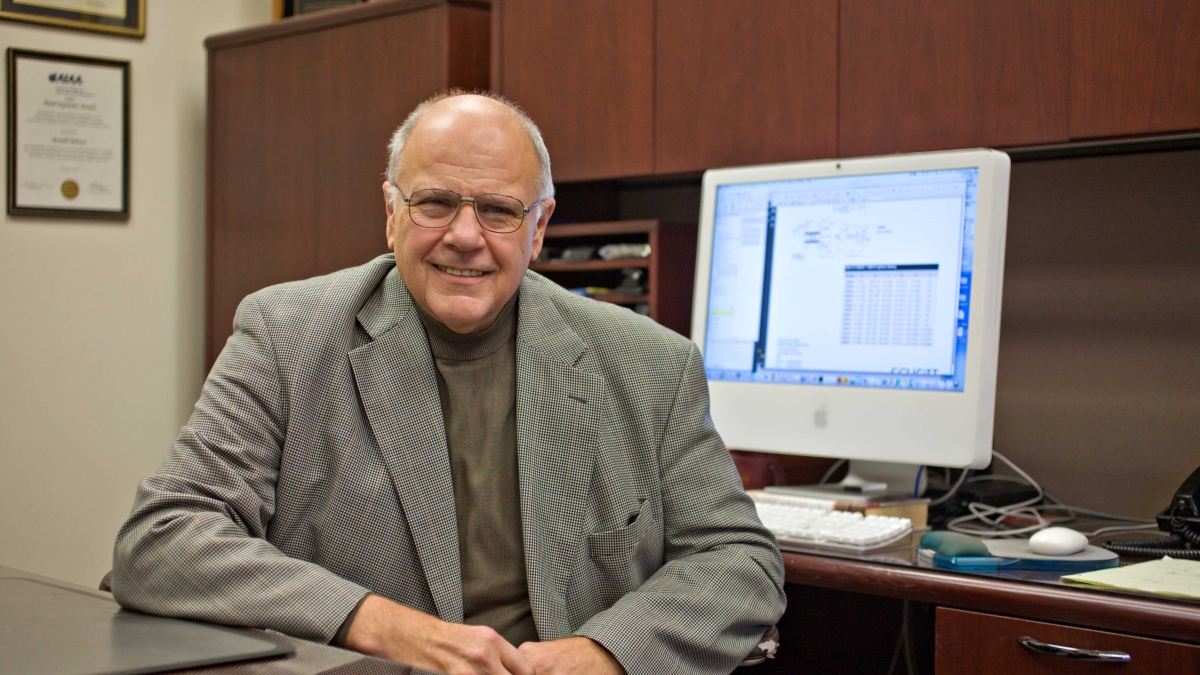Fascination with fluid motion sparked stellar engineering career

It wasn’t what he would describe as a vision, Ron Adrian explains, but he remembers “even before I started first grade I pictured myself in a white lab coat someday, doing scientific experiments. I don’t know where that came from. I was just always curious about how things worked.”
Whatever put the image in his young mind, it triggered motivation for Adrian to attain what colleague Werner Dahm describes as “immense stature” in his field of engineering.
Adrian is a professor of mechanical and aerospace engineering in the School for Engineering of Matter, Transport and Energy, one of the Ira A. Fulton Schools of Engineering at Arizona State University.
As a prominent expert in fluid dynamics, he’s been at the forefront in developing techniques and tools that have spawned new kinds of research endeavors, earned patents and become foundations for new branches of industry.
His accomplishments earned him election to the National Academy of Engineering in 1996. Now Adrian is also joining the ranks of Regents’ Professors, the highest recognition bestowed on faculty of Arizona’s state universities.
Far-reaching impact
Adrian’s prominent stature comes not only from achievements in the laboratory but as an educator and mentor “of the highest quality,” says Dahm, an ASU Foundation Professor of mechanical and aerospace engineering and former chief scientist for the U.S. Air Force.
Over a career spanning four decades, first at the University of Illinois at Urbana Champaign and then at ASU, Adrian has taught and helped develop a wide range of engineering courses that students have often judged to be among the most valuable they have taken.
Thirty-five students have earned their doctoral degrees under his supervision. Many of them, plus a number of post-doctoral assistants he supervised, have gone on to positions with leading companies, national laboratories and academic institutions.
The impact of his work has reached far beyond academia. “There is almost no experimental lab in existence today specializing in fluid mechanics without systems whose development he pioneered, and many companies that market such systems exist today because of his innovative research,” says Kyle Squires, director of the School for Engineering of Matter, Transport and Energy.
Adds Dahm: “I know of no other researcher in the field of fluid dynamics who has achieved a comparable record of recognition by his peers and by the broader scientific community.”
A world of fluids
While Adrian’s sterling reputation is for pursuits of a technological nature, his decision to become a fluid dynamicist was based on inspiration of an aesthetic nature.
“Fluid motion is beautiful,” he declares in explaining his attraction to the field. Seeking to understand the complicated mechanics of flow phenomena, such as turbulent flow, can become a kind of artistic quest, he says.
All of what the field encompasses was an alluring aspect for Adrian. “We live and breathe fluids,” he says. “Think of all the liquids and gases that make up the world.”
Think of the planet’s atmosphere, its oceans and rivers and its climate. Think of the human body and all other biological organisms. Think of the mechanical, transportation and energy systems that require gases and liquids to function. That, Adrian says, gives you a grasp of the scope of fluid dynamics.
His own grasp of the subject earned him bachelor’s and master’s degrees in mechanical engineering from the University of Minnesota, and then a prestigious Churchill Scholarship to study at Cambridge University’s Churchill College in Cambridge, England, where some of the world’s top fluid dynamicists were teaching.
Groundbreaking work
There, Adrian earned a doctoral degree in physics, which he thinks has given his work an atypical bent. “I do mechanical engineering from a physicist’s viewpoint,” he says. That perspective may have played a role in his string of significant research advances.
New experiments he devised boosted understanding of the fundamental mechanisms that govern behavior of turbulent flows. Mathematical models he developed revealed new knowledge about structure and organization within their chaotic behavior.
Among his foremost achievements are contributions to two techniques – laser Doppler velocimetry and particle image velocimetry – that provided groundbreaking tools for quantifying and measuring some of the most complex aspects of fluid mechanics.
Adrian’s work has led to more than 8,000 citations of his research manuscripts by other engineers and scientists, eight patents, and technologies that expanded the market in fluid flow measurement for research and industry.
Expertise in demand
His research has earned funding from the Department of Energy, the Office of Naval Research, the Air Force Office of Scientific Research, Los Alamos National Laboratory, the National Science Foundation and Ford Motors, among others.
His expertise has taken him to places throughout the world to address conferences, teach advanced courses and work with industry and government agencies to solve engineering problems.
In recent years, Adrian assisted the U.S. Geological Survey and the BP oil company in assessing of the size and impact of the dramatic Deep Water Horizon oil spill in the Mississippi River Delta region.
In China he helped seek solutions to massive buildups of silt that were impeding critical commercial transportation on the largest river in Asia.
More goals in sight
After a long and successful career, Adrian isn’t yet ready to narrow his aspirations.
“We’re in a position to begin answering some of the longstanding questions in fluid dynamics, so that keeps me interested,” he says.
He’d like to help solve the continuing mysteries of turbulent flow – in which fluids exhibit random motions and irregular fluctuations. That could enable reducing the energy and expense it takes to produce and deliver vital resources. There could be cost-saving reductions of the drag resulting from friction in pipelines or around vehicles, and improvements in efficiency of engineering devices that use fluids.
“We still do not have a set of mathematical governing equations to satisfactorily describe turbulent flow,” Adrian says. “I have some ideas for more reliable equations. If I can work those out, then maybe I’ll start thinking about retirement.”

